Hi.
Welcome to my blog. I write about whatever piques my interest.
contact me:
sashadavies (at) gmail.com

Welcome to my blog. I write about whatever piques my interest.
contact me:
sashadavies (at) gmail.com

In the summer of 2006, my husband and I set out to visit, interview, and, in some cases, work alongside artisan cheesemakers–mostly farmstead–across the country to better understand their experience. We called the project Cheese By Hand. The entries below provide a snapshot of the industry during a time of incredible growth and development. You can read my observations in the blog posts and listen to many of the makers we visited describe their experience in their own words in accompanying podcast episodes.

February 2006
This was a very big weekend for Cheese by Hand. We made our way up to Jasper Hill Farm in Greensboro, VT to do a "dry run" of our upcoming tour of American cheesemakers. Greensboro is in the Northeast Kingdom of Vermont, a name which I find both amazingly boastful yet accurate! Brothers Andy and Mateo Kehler have been kind to us for over two years now - we have visited the farm before and they always make us feel welcome and part of the family.

May 2006
When someone says "Vermont farmstead cheese" I think people imagine a place like Twig Farm. Michael and Emily Lee milked 17 goats and in their first cheese-producing year and made 3,000 pounds of cheese. That is a little less than 60 pounds per week. In Vermont lingo they are "flat-landers" meaning they live down in Addison county where the landscape is somewhat conducive to farming. Their barn and home blend seamlessly into the surrounding land that is thick with spindly trees and brush.

May 2006
When we grow up we want to be like Allison Hooper. A pioneer in artisan cheesemaking, she is a humble, straight shooter with a palpable passion for what she does. She and Bob Reese, the co-founder, and owner of Vermont Butter & Cheese (VBC), have grown with the industry and are now expanding it with their new production facility. In a sense Allison is returning to her cheesemaking roots - the new cheeses VBC is producing (Bijou, Bonne-Bouche, and Coupole) are the kinds of cheeses that drew her into the profession over 20 years ago when she spent time on farms in Brittany, France.

May 2006
David and Willow have truly rolled with the changes since they purchased their land in the early 90s. Beginning as an in-ground fruits and vegetable crop operation, they now have their feet firmly planted in the shepherding and cheesemaking business. A few vestiges of their old life remain- the single rectangular plot of Christmas trees now serving as a windbreak for pastures, the last of the beef cattle that will go this year, and even a couple retired chicken coops remain near the barn. Some pieces of these earlier businesses have been consistent: they have a booming, seasonal business with their organic blueberries and currants which they open up each summer for people to pick on their own and also sell at local farmer’s markets.

May 2006
We pulled into Appleton Creamery around 4 pm and cheesemaker Caitlin Hunter’s husband Brad greeted us. He walked down from his sail-making workshop (New England is almost irritatingly rife with craftspeople), which occupies the structure next to their home. Brad walked us through their 5 acres which are aesthetically pleasing and, more importantly, laden with incredible projects. As we headed down the stone path, flanked on either side by a thriving flower garden, toward the barn Brad pointed out the micro-vineyard behind the house, now in its fifth year of growth. There is a lot of cheese being made on the farm and he feels obligated to develop a variety of washes for them so he is grafting some rare cider apple species onto older root stock on one end of their land and growing hops up the side of his workshop for home brewed beer later this season.

May 2006
Trent Hendricks is a first-generation farmer in a family of real estate developers. He and his wife Rachel (and their four children) are creating something we should all be paying attention to in eastern Pennsylvania. Last November they relocated their farm to a spot about two miles down the road from the original operation.
The farm has grown out of the Hendricks’ interest in having food for their own family that is produced in a truly sustainable way, meaning ecologically and financially.

May 2006
When we called Bob Stetson to confess that a 3pm arrival at Westfield Farm was a long shot, he graciously invited us to join him and his wife Debbie for dinner that evening. So we slogged through Boston rush hour traffic and pulled into a hotel near their farm where we had an interesting chat with the receptionist about the cheeses at Westfield Farm. She is a native of Hubbardston (where the farm is located) and said that one of her childhood friends who now lives out in California called her one day to tell her that cheese was not only being made in their hometown but also written about in a national food magazine. This was clearly a point of curiosity and pride for them both- as she said, “Almost no one even knows where Hubbardston Massachusetts is, let alone that there is cheese being made there.”

May 2006
We arrived at FireFly Farms one week after they had made a big change in their operation: no more goats on the farm. After much debate, the six people who collectively run the farm decided that the cost of labor involved in caring for 200 plus goats, the complexity of expanding the herd for more milk, and the ease of acquiring high-quality goat milk from other sources in their area meant that it was time to sell the herd. Andy, the office manager (this is the closest we could get to a job title that was loose enough to include all that she does), was concerned that we would be disappointed with this change on the farm while we were thinking- how much more interesting does it get to walk onto the scene after such a huge change?

May 2006
We were greeted by Carrie Ganoe when we pulled into Everona Dairy. She makes cheese there four days a week and the owner Dr. Pat Elliott makes cheese as often as she can when not tending to her patients. Yes, she is not only a sheep dairy farmer; she also has a full time medical practice which is located on the farm, adjacent to her home. The dairy at Everona actually began because Dr. Elliott bought a Border collie puppy on impulse one weekend back in 1992. Approximately a year after, she bought some sheep because the puppy needed something to do.

June 2006
In the 80’s Helen and Rick Feete went into dairying because as they saw it the profession was stable and they would get to spend more time with each other and with their children than if they worked other kinds of jobs. Both of them worked at conventional confinement dairies. In 1988, when they decided to get cows and started their own dairy, they reacted against conventional dairy farming. This was primarily because of the cost of running a confinement dairy; they did not have the capital to invest in the equipment or the ongoing purchase of corn silage to feed the animals. Around this time they saw an article in Farm Magazine about methods used in New Zealand dairies- grass-fed, rotational grazing- and also a book by Bill Murphy, Greener Pasture is on Your Side of the Fence, came out and they could see a style of dairy that they could afford.

June 2006
Holistic. This is the word that comes to mind when I think about Goat Lady Dairy. The farm came together organically, beginning with Ginnie Tate’s move to Climax, North Carolina. She bought an abandoned tobacco farm that had a dilapidated log home on it and began the process of restoring it to prime condition. Along the way she took on a couple of goats and earned the nickname "the goat lady" with locals in town, some of whom she hired to help restore her home. The other members of the Tate family came later on; Steve Tate and his family enjoyed the visits they made to Climax in the summer months but it wasn’t until years later that they thought about moving there and developing the farm with Ginnie.
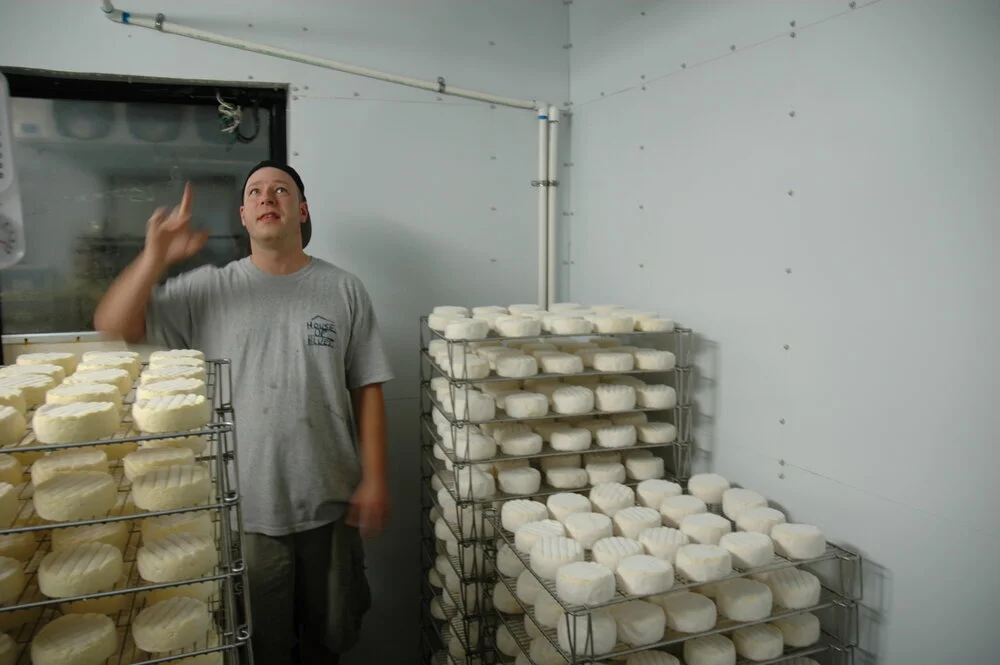
June 2006
Many people associate Sweet Grass cheeses with Desiree Wehner, Jessica’s mother, who started the dairy. Desiree and her husband Al are known throughout the grass-based, rotational grazing cow dairy world as an example to be followed; not to mention that they are known throughout southern Georgia as right good people. Al and Desiree were conventional dairy farmers who became disenchanted with dairying and decided to try something different. Similarly to Helen and Rick Feete, the Wehners turned to the New Zealand model and created Green Hill, a 340 acre rotational grazing facility currently milking approximately 500 cows. In the late 90’s a variety of circumstances lead the Wehners to move into Thomasville onto 140 acres. Desiree saw an opening to have the handful of goats she had always wanted and the development of Sweet Grass Dairy began.
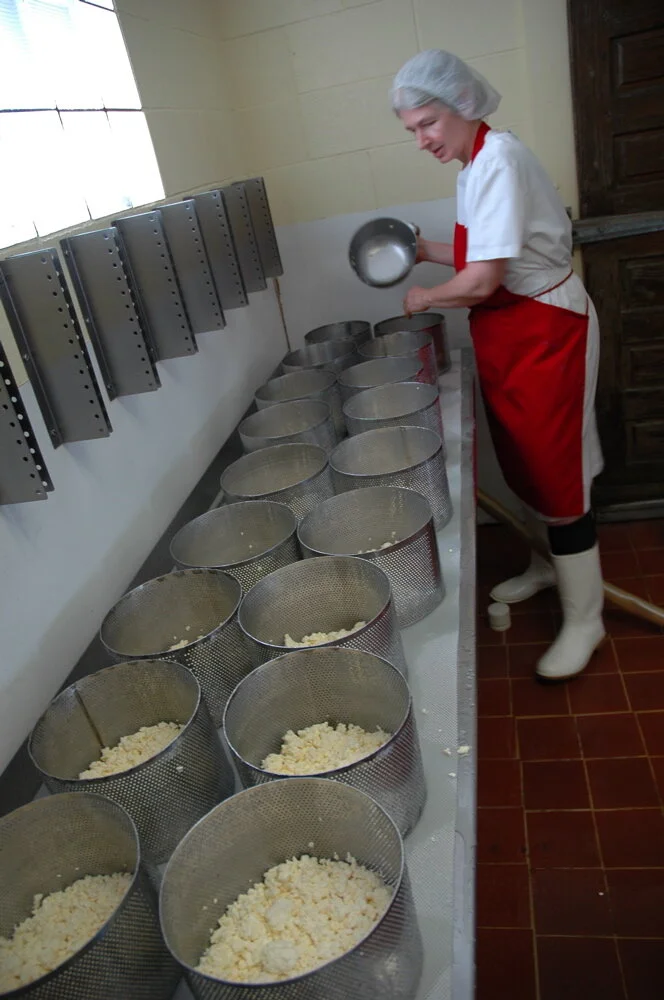
June 2006
Everything at Sweet Home Farm is done to please both the functional and the aesthetic. The first thing you see when you pull into the farm is a chicken coop that is so sweet (and so well kept) it could break your heart. I knowI’m really selling the bucolic image here- but it would be a disservice to not talk about the craftsmanship involved in the entire operation that makes up Sweet Home Farm. There are only two "employees" Alyce Birchenough and her husband Doug Wolbert, they are also the owners. This means that they are the gardeners, the repair people, the milkers, cheesemakers, and as if that were not enough they are shopkeepers too. All of the cheese produced is sold on the farm, not to prove a point, but to keep things simple.
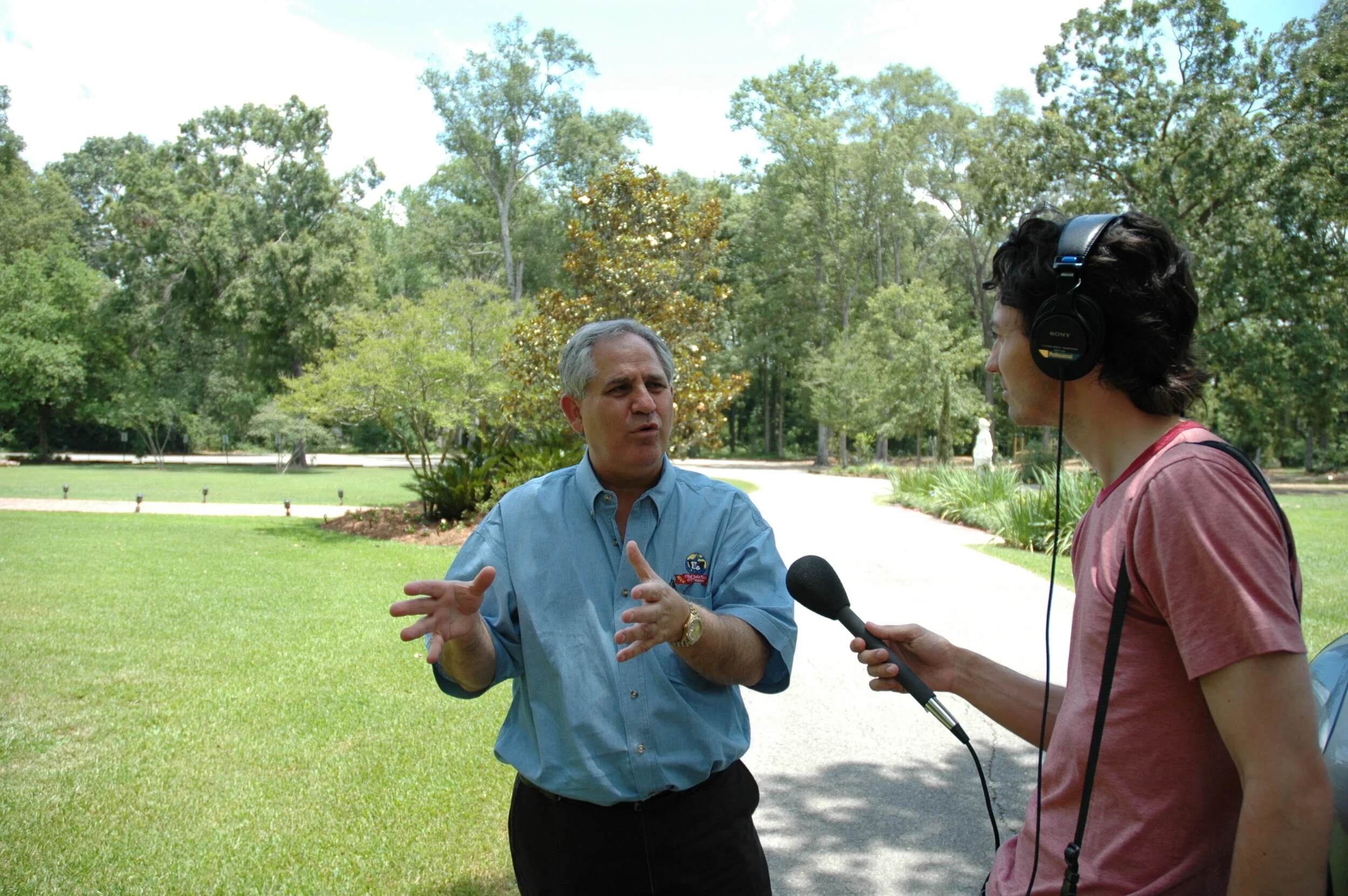
June 2006
Hanging out with Chef John Folse is like having a live audio tour of the cultural and culinary Cajun and Creole history. The full day we spent touring all parts of his company was like participating in an immersion program... seriously.

June 2006
Pure Luck Dairy straddles Twin Oaks Trail, we learned this by barging in on Denny Bolton in the Pure Luck Office who kindly directed us to the dairy where we found someone who could find Amelia for us. Many of you who are familiar with Pure Luck know that the farm is going through a large transition with the loss of its founder Sara Bolton last November. Amelia Sweethardt is her daughter and also has been a cheesemaker at the dairy since 1997. She has taken over the cheesemaking reigns. In addition to Amelia, two of Sara’s other daughters Claire and Hope also assisting with multiple aspects of the dairy, not to mention Denny Bolton (Sara’s husband and partner in the business) and Gitana Sweethardt who also helps run Pure Luck. All four of Sara’s girls grew up milking goats and drinking fresh milk from their own farm so they understand the value of what they do let alone the work required to run the dairy.

June 2006
I called Paula from the road when we were nearing Dallas and asked her if she was still at the photoshoot she had been part of over the last few days (she is one of the busiest people I know)...she assured me that she was doing nothing at that moment except waiting for Michael and me to arrive and tell her all about our travels. So when we arrived we gave Paula and her husband Jim a bit of an update over dinner, at a restaurant called Ciudad, which included some fantastic upscale tex-mex food (her cheese was indeed on the menu).
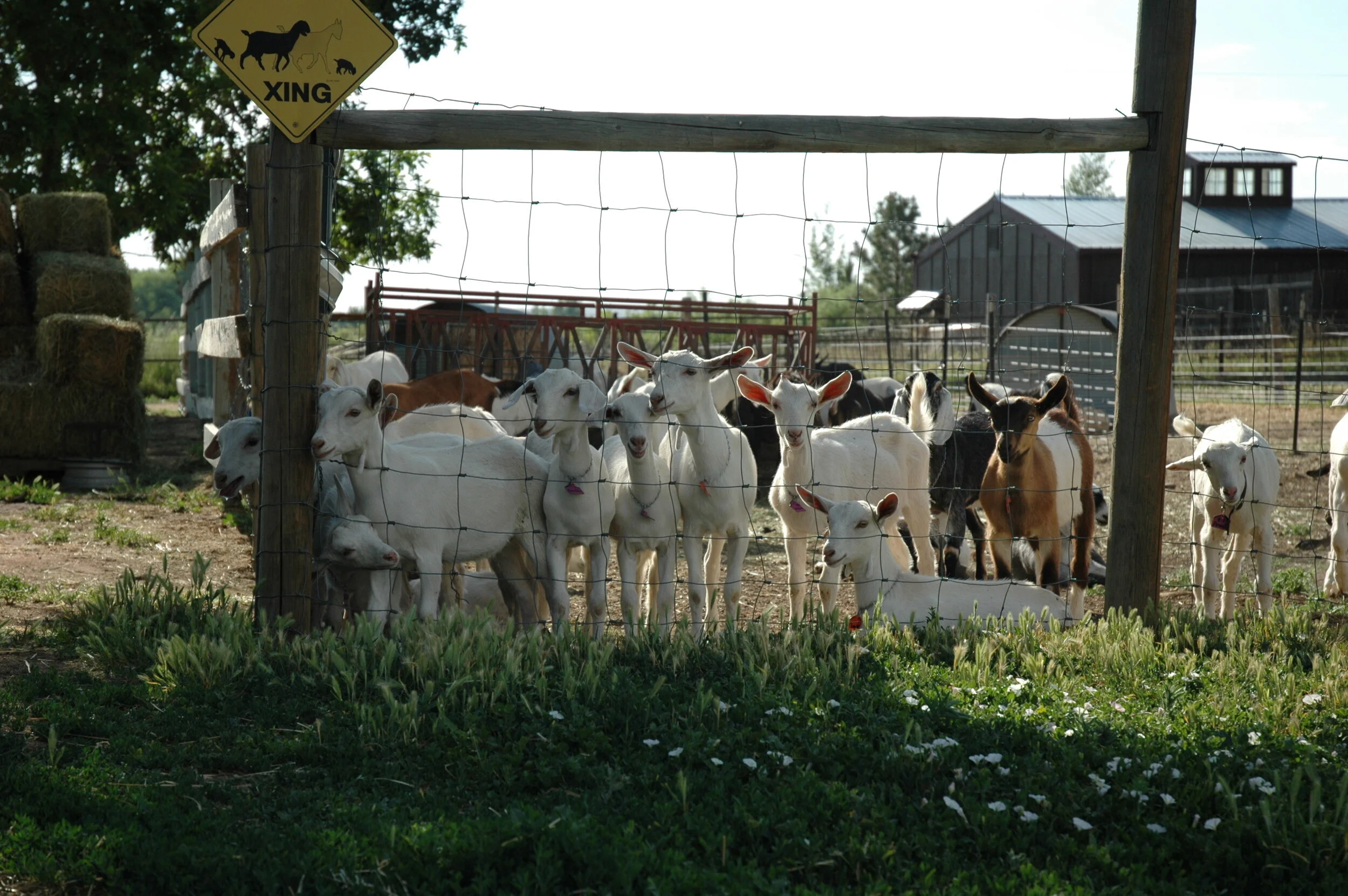
June 2006
Back in 1989, Jim and his family moved to Niwot, Colorado, purchased some land, bought five goats, and began milking them by hand to make cheese. After a long career in education, he was looking for a change of pace, dare I say a route towards retirement. The herd grew slowly, and by the time he got up to 25 goats he decided to go visit a few people that had been doing the goat cheese thing before he got in much deeper. When he began cheesemaking he had a staff of one- his daughter Gretchen. Jim affectionately refers to those times as the "beer and chips days" because at the end of the day he and his daughter were so exhausted that the most they could do was slug back a beer and have some chips and salsa before bed...and then get up again the next morning for milking and cheesemaking.
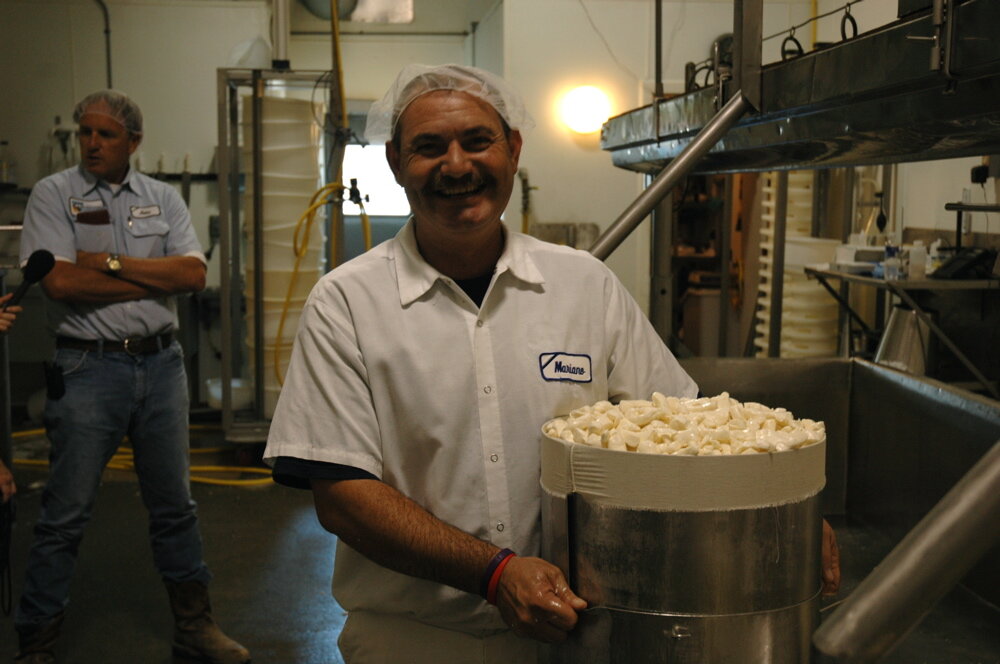
July 2006
Fiscalini Farm was our first visit to a cow dairy with more than 150 animals and the first cow dairy that is a confinement operation (we have seen some quite large goat dairies that are confinement based). I wasn’t sure how I would feel about a confinement operation- along with many others in food I read Fast Food Nation and I’ve been delving into the Omnivore’s Dilemma and had formed a somewhat negative opinion of the concept. Mostly I was curious because the Fiscalinis are much much smaller than other confinement operations in California- case in point the "farm" we drove by on our way up I-5 that is home to at least 10,000 cows (more on that in a later post). Fiscalini is milking 1500 Holsteins which means that the total number of animals on their land is 3000; they are using free stall barns and feeding the cows a total mixed ration (TMR) of various grains and hay rather than grazing them on grass.

July 2006
A couple of years ago I read an article about Soyoung Scanlan in Saveur magazine and something about it moved me. I’m sure I was not alone in this feeling its just that I was also working in cheese at the time and grew up about one hour away from her cheesemaking plant. Since reading that article I have been scheming to visit Andante- with our cheese tour I had my opening. In April of this year, Andante moved from Santa Rosa to Petaluma; more specifically to the top of one of the velvety rolling hills of Petaluma. Soyoung’s facility shares this hilltop with the goats of Volpi Ranch that provide the milk for some of her cheeses.

July 2006
Although the 24 milking goats can browse all the way down to Dry Creek Road, one might never noticed Pug’s Leap because it is nestled back on the hillside among trees and brush so common to the not-quite-coastal valleys of Northern California. Lucky for us- thank you Healdsburg Farmer’s Market- Pug’s Leap was presented to us in broad daylight. We introduced ourselves and thanks to the avid local food supporters of a blog called Fork and Bottle who wrote about us on their slow food convivium’s site, Eric and Pascal had actually heard of us and graciously invited us out to the farm that afternoon.

Cypress Grove: California
July 2006
We had one of those is-this-really-our-life mornings the day we went to see Mary Keehn. Up at 6 AM in our tent deep in Humboldt Redwoods State Park. We had some charred toast and cantaloupe with our friends Rose and Dave before winding our way out of the Redwoods to Highway 1. Of course, all of that took a lot more time than we anticipated so we arrived at Cypress Grove at 9:30 instead of 8:30. Mary held no grudge- major props to her as it wasn’t just any Monday morning, it was July 3rd.
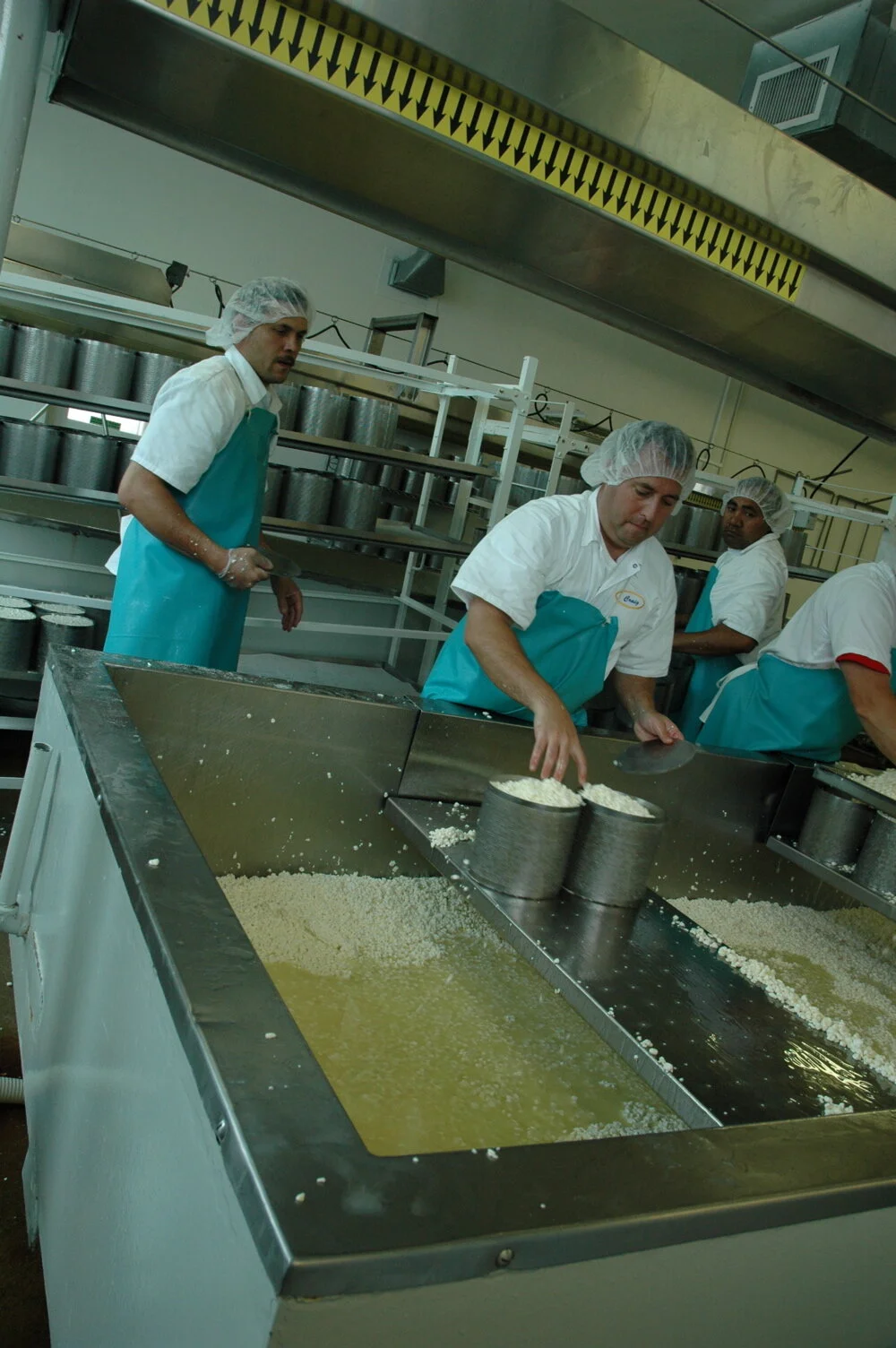
August 2006
The first order of business when we arrived at Rogue was an in-depth tour with David. Before he caught wind of our presence we perused the creamery’s retail store where they have a combination of local and Italian cheeses, wines, and food stores. The Italian bit catches you off guard until you hear about the history of this place and the celebration of Italian heritage that has been part of the creamery since 1935.
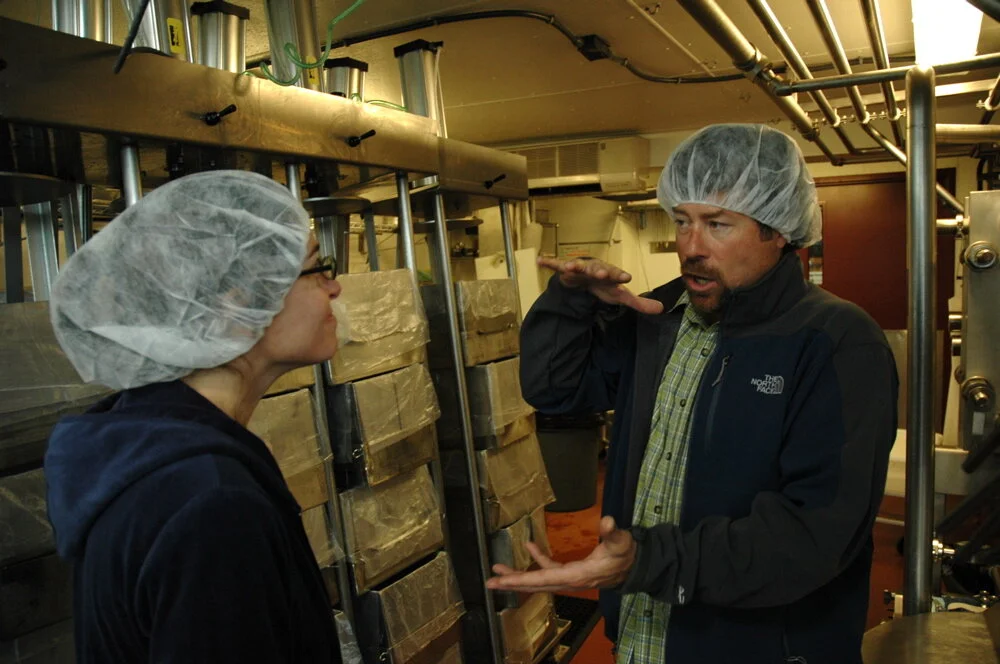
August 2006
Kurt Dammeier is the first to admit that he kind of backed into the cheese business... he found the perfect location for cheesemaking, signed a lease, and went in search of milk, a cheesemaker, and a recipe after setting up his cheesemaking room. Milk turned out to be surprisingly tough to find in the quantity and, more importantly, of the quality he needed. There were a couple of dairies interested in working with him- largely because of recent changes in the local milk coop structure.

August 2006
Gary Beau has lived in Alaska since he was 10 years old and for some inexplicable reason, for as long as he can remember, he wanted to have a farm in Palmer. Palmer lies in the Matanuska Valley, the primary- if not the only agricultural belt in Alaska. He and his wife Carla ran a successful small airplane business for decades before they purchased a forested lot at the end of a road in Palmer in 1990. With the assistance of seven sheep, they cleared the land for building. In 1992 their next-door neighbor (a family of 9) decided they needed a milk cow. [Note that at this point in the conversation Gary does mention that he never wanted to be a dairy farmer because dairy farmers are stuck: they’ve got to milk twice a day every day.] So their neighbor asks them if they would go in on a cow with them; they would trade off every three months so no one would be stuck milking year-round.

August 2006
Matt grew up in Alaska and has always had a strong inclination to stay close to the land. He did spend some time in the lower 48, where he met his wife Rhonda but found that he missed the comfort of being surrounded by mountains that he found in Alaska. Rhonda had spent years working in cow dairies in the Midwest developing an in-depth knowledge of animal husbandry practices and also becoming an artificial insemination expert. The two of them have built Cranberry Ridge Farm from the ground up. Matt built their home with help from his father and also cleared a number of sections of thick trees to create areas for livestock to browse. On their 10 acres, they’ve got 24 milking goats and the total goat population is probably double that number. Their goal someday is to be milking 60 goats. The Shaul’s also have horses (which they will ideally be able to use almost exclusively to work the land), chickens, turkeys, 3-4 grass-fed beef cattle per year, and a handful of peacocks that were given to them as a gift.

August 2006
Pat Morford’s farm is exactly as she has drawn it on her label- drooping Sitka Spruce and Douglas Firs along the edge of the open pasture, goats, and a handful of sheep frolicking up into the forest a bit or retreating from the sun in the loafing shed. She has had goats since she was a small girl and remembers clearly the names of the first three her father purchased. Stripes was traded, Jack and Pinky stuck around long enough to provide some good meat for tamales.
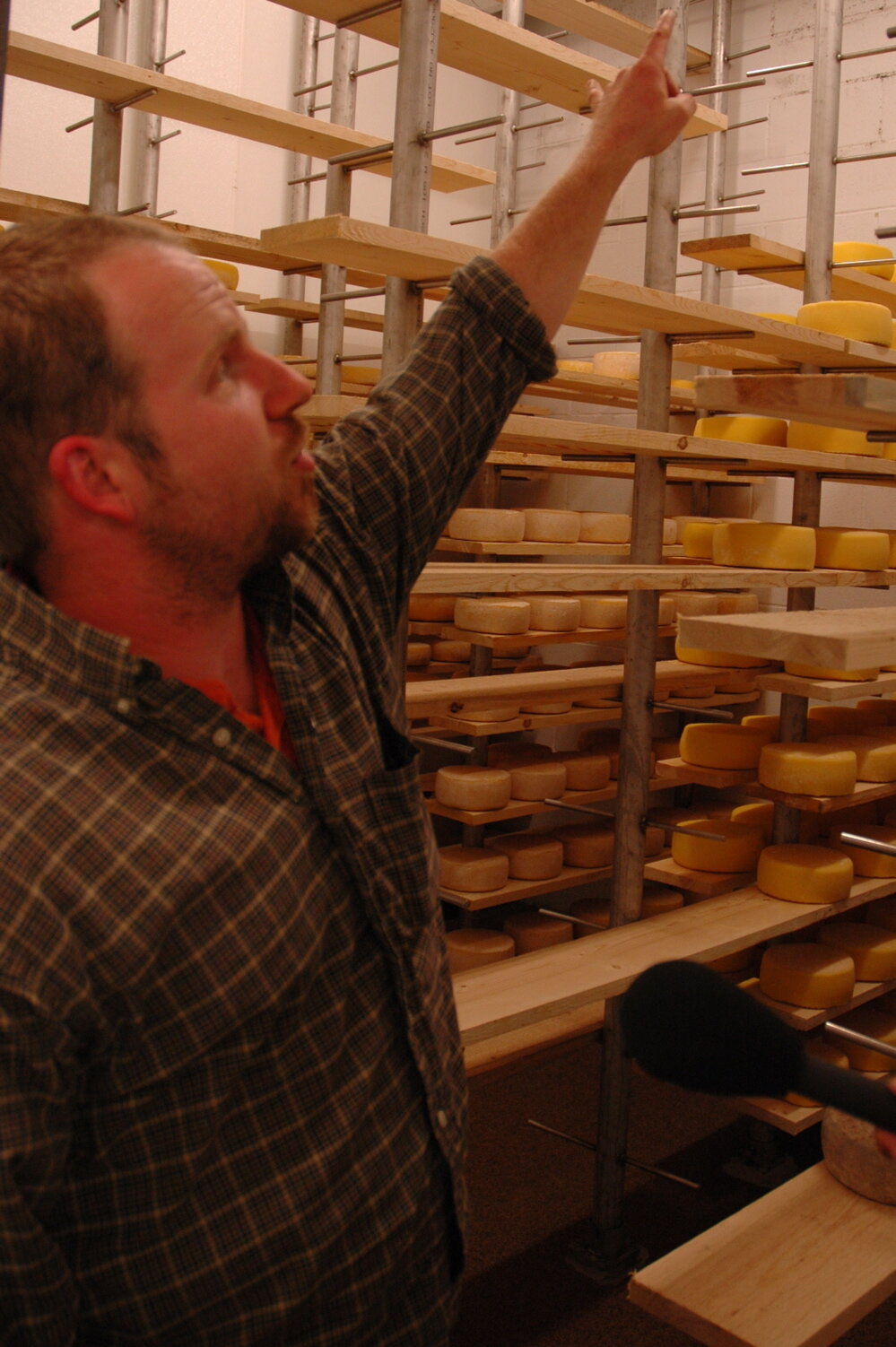
August 2006
So our friends Matt and Milissa got married in southern Washington the last weekend in July. This meant that we had a few "free" days to explore the Oregon coast north of Rivers Edge Chevre and areas of Washington beyond Seattle. Lucky for you, we got a tip-off from Kurt D. (Beecher’s) about great cheesemakers in his home state. While at a farmers market in the Ballard neighborhood of Seattle we confirmed this by tasting and then purchasing some of Mt. Townsend Creamery’s signature cheeses- Seastack and Trailhead. We forced our business cards on them and a few days later we received a phone call welcoming us to stop on by if time permitted.

August 2006
There I was pitching our project to Kelli Estrella (Estrella Family Creamery) at the Ballard Farmers' Market unknowingly standing right next to another farmer. When I strolled away, the farmer walked up to me and said he wanted to tell me about his farm, and I gave him the green light to let it rip. This man is George Page, and he owns Sea Breeze Farm on Vashon Island. He and his wife and daughter live in a house on 8.85 acres (3.85 when they first purchased it) with a whole raft of animals (see list above). George doesn't do it all alone. He has a farm manager, Matt Lawrence, who was operating the stand at the market with him that day. As he described the way he manages his farm–graze cows, goats, and sheep on grass, run chickens after them, move pigs around to clear roots and prepare the land for more pasture–my mind went to the section of Michael Pollan's "Omnivore's Dilemma" that covers Polyface Farm. I mentioned this to George, and his eyes lit up. He had just finished reading the book himself and explained how confirming it had been for him. He told me that people are continually pressuring him to specialize rather than diversify. Yet, whenever he removes a single part of his operation, the whole of it doesn't run as well.
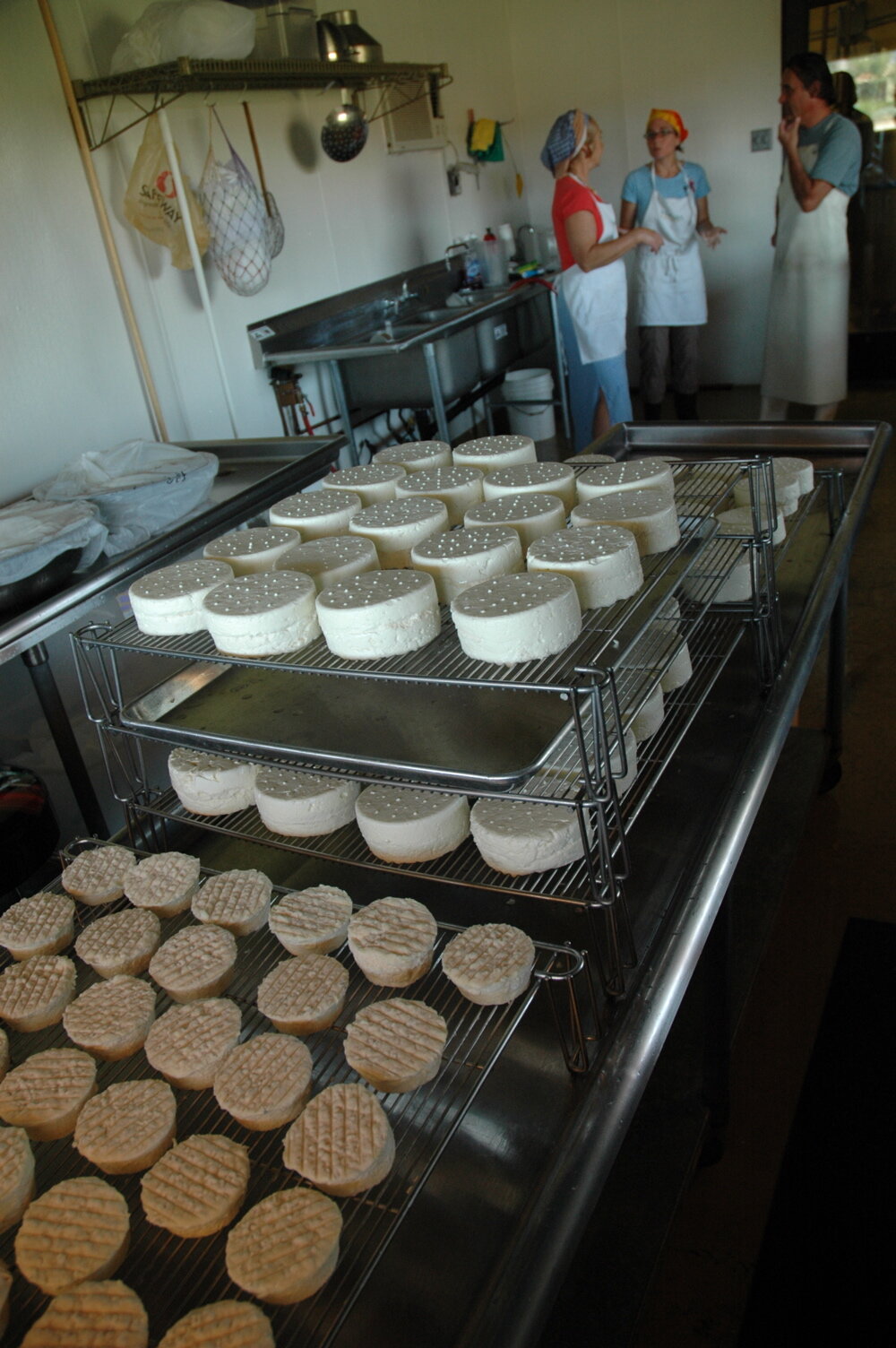
August 2006
Joan Monteillet warned me multiple times that I would not want to leave Walla Walla once I had witnessed firsthand all of the amazing things happening there. She was right in all ways except one, it was largely what was going on right at Monteillet Fromagerie that makes me want to stay. When we arrived Joan and Pierre-Louis were just finishing up a late lunch (4 pm) with some friends who had stopped by for an impromptu visit. Pierre-Louis had just returned from the weekly trip to Portland and Seattle to drop cheese and restaurants and, most importantly, sell their cheeses at the farmers’ markets. So we settled in at the table, brought in a bottle of California Pinot Noir (Papapietro Perry), and sampled some of their delectable cheeses.

August 2006
Rollingstone Chevre is celebrating its 18th anniversary this month! Many congratulations to Chuck and Karen Evans. I can only imagine what the chevre market was like when they started out in 1988 and they were the first Grade A goat dairy in the state of Idaho- true pioneers. They don’t seem to see themselves as pioneers though, their move into dairy was a gradual one and it all began with the family goat they purchased because their daughter was allergic to cow milk. All of this began in Michigan where they lived with their first goats until moving to the town and home where Chuck grew up in Parma, Idaho.

August 2006
We stopped by the cheese facility to see Sue late in the afternoon on the day before our official visit. She talked to us a bit about how Amaltheia got started and took us on a tour through their cheese plant which is located in the town of Belgrade in a small industrial park. Originally the Browns wanted to build the cheesemaking facility on their land but the state wanted to do a $13,000 EPA study before they would give them the green light to apply for building permits so they secured a spot at an industrial park close to the farm. They’ve got the standard setup- a bay to park their milk truck which collects from the farm every 2-3 days, a 1,000 gallon vat pasteurizer, a large mixer for their flavored chevres, a large walk-in cold storage space and a packaging room. There is additional space for packing materials and they do have an additional cold space that could potentially serve as a maturing area for other styles of cheese.

September 2006
I think that most of us have had an experience in life where we think we are set; we think we are finished with the struggling and on our way to something until we find out, that like some kind of cruel joke, the counter has been set back to mile one. And not only are we back at the beginning but usually, we are suffering too- not only from our setback but also disbelief and frustration at our own bad luck. Imagine that you managed to get yourself through the multitude of hoops on the route to farmstead cheesemaking. You pooled enough resources together to get an adequate piece of land, developed a product that sells, settled on a distribution plan, and grew your herd from the ground up, and held a strong place in the market for a solid decade only to be thwarted by an incident that was worse than most you could have imagined. This is what happened to Jodi and Steven at Shepherd’s Way Farm.

September 2006
When Jeff Jirik says that the Faribault Dairy is a national treasure I wholeheartedly agree. Although the space was first used to produce beer, as a result of its natural characteristics it is ideal for maturing cheese. Faribault Dairy is located in the small town of Faribault, MN. The buildings that are visible from the outside run along a small river and the majority of the facility is built into a tall sandstone bluff. It is not your run-of-the-mill sandstone, rather, it is St. Peter Sandstone. St. Peter’s Sandstone is beach sand deposit from the glaciers of the last glacial age. This sandstone allows water to migrate through it both horizontally and vertically and has a natural capacity for absorbing ammonia just to name a couple of the traits that make it valuable for cheese maturation.

September 2006
Even fourth-generation Wisconsin cheesemakers will tell you that Mike and Carol Gingrich are the ultimate artisan cheese success story. Mike worked at Xerox for years when he and his family lived in Southern California where they were both raised. At some point along his corporate path, Mike realized that he was ready for a different lifestyle. Having enjoyed time he spent on the farms of his aunts and uncles when he was a boy, he thought that farm living would be an interesting experience for his own family. Needless to say it was an adjustment- but one that in the long-term they are glad they made. Mike started out raising beef cattle for a few years and eventually switched to dairy farming. He and Carol milked 30 cows for years before they began talking with friends Dan and Jeanne Patenaude their community about becoming partners in a larger dairy.
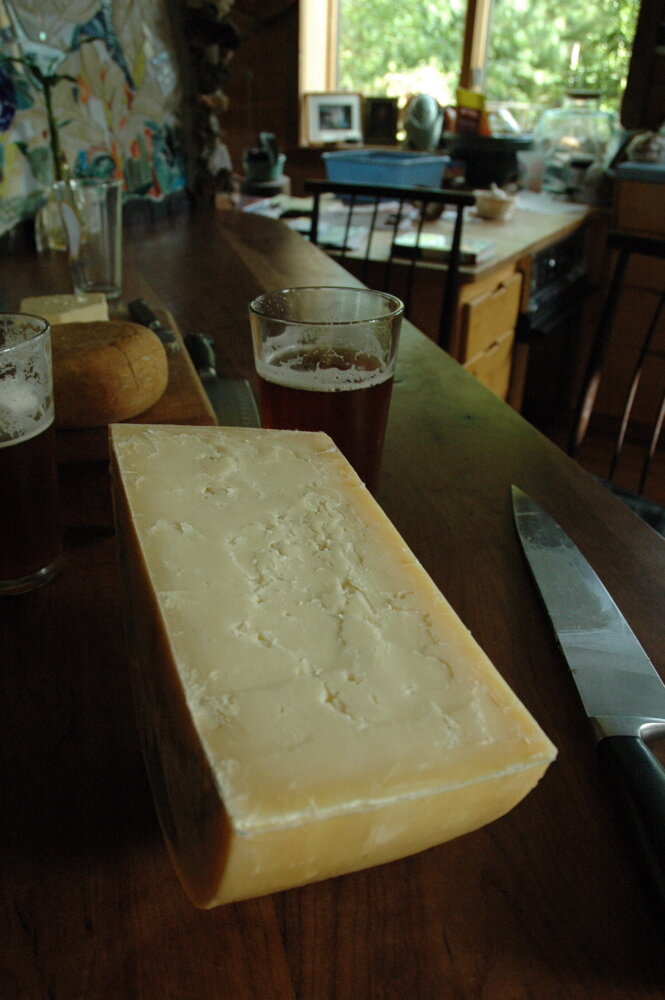
September 2006
We first met Willi at the Madison farmers’ market which is the largest market of its kind in the U.S. (it has the largest number of producers). There are many cheesemakers at the Madison market and Willi has a prime piece of real estate there. It is a priority for him as he only sells his cheese at the market- to both retail and restaurant customers alike. He is a natural salesman- at least in the cheese world- because he understands that the fastest way onto someone’s cheese plate is via their taste buds... he samples his cheese to you immediately when you approach the stand. I first heard about Bleu Mont Dairy from Mike Gingrich. Mike suggested that we visit Willi on our tour of Wisconsin because he is doing things differently than anyone else on our Cheese by Hand roster.

September 2006
I am wondering if anyone else out there in cheeseland is wondering how Sid Cook’s Carr Valley Cheese pumps out over 65 varieties of cheese in what seems to be a sizable volume... I have been thinking about this for three years at least and could only imagine that he was like the Willy Wonka of cheese. Of course, the less optimistic part of my mind was wondering if it was going to feel like a big factory... my first instinct was definitely closer to what I actually saw.

September 2006
We hit the ground running when we arrived at Crave Brothers. Debbie and I had met briefly in July at the ACS conference. George was part of a panel about the terroir of the dairy cow. It was definitely one of the more interesting things I attended at the conference because it covered the areas that are not usually discussed by cheese retailers and enthusiasts but are integral to the production of cheese: animal and land management. Crave Brothers is run by four brothers: Charles, Thomas, Mark, and George. They grew up on a 40 cow, family-size farm in Wisconsin. In the current operation, each brother has an area of responsibility best suited to their interests and skills. Charles manages crops and equipment upkeep, Thomas monitors animal health and compiles the feed, Mark is responsible for milking operations, and George runs the cheese operation.

September 2006
Oakvale Farm is a beautiful example of a dairy farm and farmstead cheese operation involving multiple generations of one family. Dale King grew up on a dairy farm in Hilliard, now a bustling suburb of Columbus, OH. Until about 10 years ago, he and his brother had a successful 100 cow dairy and grain farm in Hilliard on a piece of land that had been in their family since 1853. When they decided to give up that farm they were milking their 100 cows in a parlor that was 100 yards away from a subdivision. Dale says that he and his brother could see the writing on the wall- urban creep was not abating any time soon. So they sold and Dale and Jean started over in a new community just 20 miles west of Columbus.

September 2006
Karen Weinberg has always known that she wanted to be a farmer. She didn’t grow up on a farm, she didn’t spend time working on a farm- yet somehow she just knew that farming was in the cards for her. Being the ambitious woman that she is she lobbied hard for her dream with her husband Paul and yet she was humble enough to take his coaching. He explained to her that in order to be a successful farmer she needed to have capital and an education. Once she had her Ph.D., her first baby, and the couple owned a small apartment in Brooklyn they began looking for farmland in New York state.

October 2006
Elizabeth began farming in the late ’70s when she bought the land that Cato Corner Farm stands on today. She started out raising sheep and goats for meat. This was a largely seasonal business cycle- the animals were born, raised, and then slaughtered in the spring and summer. Seasonal is not ideal economically and unfortunately, it doesn’t mean that once your season is over you get to take the rest of the year off as there are always things to be done on the farm and the ewes, does, rams and bucks have to be fed throughout the winter. So after a decade of producing meat, Elizabeth began thinking about other ways of farming. In the early days, she was working with 150 sheep and 40 some odd goats who produced lamb and kids each year. She talked to us about her meat farming days while she was waiting for their vet to show up to do some routine checks on their herd.